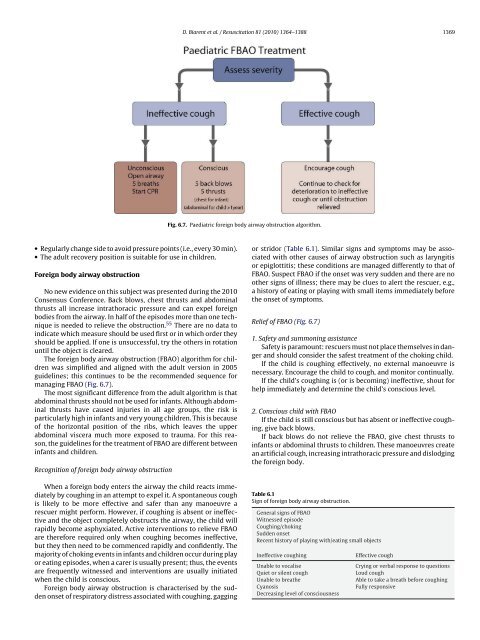European Resuscitation Council Guidelines for Resuscitation 2010 ...
European Resuscitation Council Guidelines for Resuscitation 2010 ...
European Resuscitation Council Guidelines for Resuscitation 2010 ...
You also want an ePaper? Increase the reach of your titles
YUMPU automatically turns print PDFs into web optimized ePapers that Google loves.
D. Biarent et al. / <strong>Resuscitation</strong> 81 (<strong>2010</strong>) 1364–1388 1369<br />
Fig. 6.7. Paediatric <strong>for</strong>eign body airway obstruction algorithm.<br />
• Regularly change side to avoid pressure points (i.e., every 30 min).<br />
• The adult recovery position is suitable <strong>for</strong> use in children.<br />
Foreign body airway obstruction<br />
No new evidence on this subject was presented during the <strong>2010</strong><br />
Consensus Conference. Back blows, chest thrusts and abdominal<br />
thrusts all increase intrathoracic pressure and can expel <strong>for</strong>eign<br />
bodies from the airway. In half of the episodes more than one technique<br />
is needed to relieve the obstruction. 55 There are no data to<br />
indicate which measure should be used first or in which order they<br />
should be applied. If one is unsuccessful, try the others in rotation<br />
until the object is cleared.<br />
The <strong>for</strong>eign body airway obstruction (FBAO) algorithm <strong>for</strong> children<br />
was simplified and aligned with the adult version in 2005<br />
guidelines; this continues to be the recommended sequence <strong>for</strong><br />
managing FBAO (Fig. 6.7).<br />
The most significant difference from the adult algorithm is that<br />
abdominal thrusts should not be used <strong>for</strong> infants. Although abdominal<br />
thrusts have caused injuries in all age groups, the risk is<br />
particularly high in infants and very young children. This is because<br />
of the horizontal position of the ribs, which leaves the upper<br />
abdominal viscera much more exposed to trauma. For this reason,<br />
the guidelines <strong>for</strong> the treatment of FBAO are different between<br />
infants and children.<br />
Recognition of <strong>for</strong>eign body airway obstruction<br />
When a <strong>for</strong>eign body enters the airway the child reacts immediately<br />
by coughing in an attempt to expel it. A spontaneous cough<br />
is likely to be more effective and safer than any manoeuvre a<br />
rescuer might per<strong>for</strong>m. However, if coughing is absent or ineffective<br />
and the object completely obstructs the airway, the child will<br />
rapidly become asphyxiated. Active interventions to relieve FBAO<br />
are there<strong>for</strong>e required only when coughing becomes ineffective,<br />
but they then need to be commenced rapidly and confidently. The<br />
majority of choking events in infants and children occur during play<br />
or eating episodes, when a carer is usually present; thus, the events<br />
are frequently witnessed and interventions are usually initiated<br />
when the child is conscious.<br />
Foreign body airway obstruction is characterised by the sudden<br />
onset of respiratory distress associated with coughing, gagging<br />
or stridor (Table 6.1). Similar signs and symptoms may be associated<br />
with other causes of airway obstruction such as laryngitis<br />
or epiglottitis; these conditions are managed differently to that of<br />
FBAO. Suspect FBAO if the onset was very sudden and there are no<br />
other signs of illness; there may be clues to alert the rescuer, e.g.,<br />
a history of eating or playing with small items immediately be<strong>for</strong>e<br />
the onset of symptoms.<br />
Relief of FBAO (Fig. 6.7)<br />
1. Safety and summoning assistance<br />
Safety is paramount: rescuers must not place themselves in danger<br />
and should consider the safest treatment of the choking child.<br />
If the child is coughing effectively, no external manoeuvre is<br />
necessary. Encourage the child to cough, and monitor continually.<br />
If the child’s coughing is (or is becoming) ineffective, shout <strong>for</strong><br />
help immediately and determine the child’s conscious level.<br />
2. Conscious child with FBAO<br />
If the child is still conscious but has absent or ineffective coughing,<br />
give back blows.<br />
If back blows do not relieve the FBAO, give chest thrusts to<br />
infants or abdominal thrusts to children. These manoeuvres create<br />
an artificial cough, increasing intrathoracic pressure and dislodging<br />
the <strong>for</strong>eign body.<br />
Table 6.1<br />
Sign of <strong>for</strong>eign body airway obstruction.<br />
General signs of FBAO<br />
Witnessed episode<br />
Coughing/choking<br />
Sudden onset<br />
Recent history of playing with/eating small objects<br />
Ineffective coughing<br />
Unable to vocalise<br />
Quiet or silent cough<br />
Unable to breathe<br />
Cyanosis<br />
Decreasing level of consciousness<br />
Effective cough<br />
Crying or verbal response to questions<br />
Loud cough<br />
Able to take a breath be<strong>for</strong>e coughing<br />
Fully responsive
















